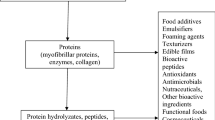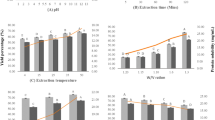Abstract
Salmon-processing co-products (fish frames containing bones, skin, and scales) were used to recover fish protein isolate (FPI) with isoelectric solubilization/precipitation (ISP) of protein at pH 12 and pH 5.5, respectively. Based on microbiological examination, FPI does not appear to present a microbiological safety concern. In fact, ISP may improve the microbial safety of FPI. In laboratory-scale experiments, different ratios of water and FPI (10:0, 10:1, 10:2, and 10:5; w:w) were used to prepare FPI-brine containing 15 or 20 g/100 ml of NaCl. The FPI brine was injected into salmon fillets before smoking. Based on laboratory-scale results, only a 10:5 ratio was tested at pilot scale in low- and high-quality fillets. Not only did the addition of FPI to brine increase (p < 0.05) the weight of smoked salmon, but it also reduced (p < 0.05) the number of injections and injection time by approximately 50%. FPI addition improved overall sensory quality at the laboratory scale but not at the pilot scale. FPI was also used as a partial replacement of salmon mechanically separated meat (MSM) in fish patties at a laboratory and pilot scale. The addition of up to 50% of FPI to fish patties in laboratory-scale experiments did not (p > 0.05) increase cook loss, but the texture was less acceptable due to their almost paste-like consistency and appearance. Adding up to 30% of FPI to fish patties in pilot-scale experiments resulted in lower (p < 0.05) cook losses and acceptable sensory quality. This study demonstrated that the advantages of FPI at the laboratory scale produced similar benefits at the pilot scale for seafood such as smoked fish and restructured products. The injectable FPI-brine and fish patties tested in this study at laboratory and pilot scales may be an advancement for commercial applications of FPI.
Graphical Abstract








Similar content being viewed by others
Data Availability
No datasets were generated or analyzed during the current study.
References
Abachi, S., Offret, C., Fliss, I., Marette, A., Bazinet, L., & Beaulieu, L. (2022). Isolation of immunomodulatory biopeptides from Atlantic Mackerel (Scomber scombrus) protein hydrolysate based on molecular weight, charge, and hydrophobicity. Food and Bioprocess Technology, 15(4), 852–874.
Abdollahi, M., & Undeland, I. (2019). Physicochemical and gel-forming properties of protein isolated from salmon, cod and herring by-products using the pH-shift method. LWT-Food Science and Technology, 101, 678–684.
Abdollahi, M., Rezaei, M., Jafarpour, A., & Undeland, I. (2017). Dynamic rheological, microstructural and physicochemical properties of blend fish protein recovered from kilka (Clupeonella cultriventris) and silver carp (Hypophthalmichthys molitrix) by the pH-shift process or washing-based technology. Food Chemistry, 229, 695–709.
Agarwal, S., Beausire, R. L., Patel, S., & Patel, H. (2015). Innovative uses of milk protein concentrates in product development. Journal of Food Science, 80(S1), A23–A29.
Ananey-Obiri, D., Matthews, L. G., & Tahergorabi, R. (2019). Proteins from fish processing by-products. In Proteins: Sustainable source, processing and applications (pp. 163–191). Academic Press.
AOAC (1990). Official methods of analysis of the association of official analytical chemists, 15th edition, In K. Helrich (Ed.) AOAC, Arlington, p. 1298.
Carter, B. G., Cheng, N., Kapoor, R., Meletharayil, G. H., & Drake, M. A. (2021). Invited review: Microfiltration-derived casein and whey proteins from milk. Journal of Dairy Science, 104(3), 2465–2479.
Chen, Y. C., & Jaczynski, J. (2007). Protein recovery from rainbow trout (Oncorhynchus mykiss) processing byproducts via isoelectric solubilization/precipitation and its gelation properties as affected by functional additives. Journal of Agricultural and Food Chemistry, 55(22), 9079–9088.
Chen, Y. C., Tou, J. C., & Jaczynski, J. (2007). Amino acid, fatty acid, and mineral profiles of materials recovered from rainbow trout (Oncorhynchus mykiss) processing by-products using isoelectric solubilization/precipitation. Journal of Food Science, 72(9), C527–C535.
Fu, J., He, Y., & Cheng, F. (2023). Intelligent cutting in fish processing: Efficient, high-quality, and safe production of fish products. Food and Bioprocess Technology, 1–22.
Gehring, C. K., Davenport, M. P., & Jaczynski, J. (2009). Functional and nutritional quality of protein and lipid recovered from fish processing by-products and underutilized aquatic species using isoelectric solubilization/precipitation. Current Nutrition & Food Science, 5(1), 17–39.
Gehring, C. K., Gigliotti, J. C., Moritz, J. S., Tou, J. C., & Jaczynski, J. (2011). Functional and nutritional characteristics of proteins and lipids recovered by isoelectric processing of fish by-products and low-value fish: A review. Food Chemistry, 124(2), 422–431.
Gudjónsdóttir, M., Karlsdóttir, M. G., Arason, S., & Rustad, T. (2013). Injection of fish protein solutions of fresh saithe (Pollachius virens) fillets studied by low field nuclear magnetic resonance and physicochemical measurements. Journal of Food Science and Technology, 50, 228–238.
Guo, X., Wang, D., He, B., Hu, L., & Jiang, G. (2023). 3D bioprinting of cultured meat: A promising avenue of meat production. Food and Bioprocess Technology, 1–22.
Hultin, H. O., & Kelleher, S. D. (2000). U.S. Patent No. 6,136,959. Washington, DC: U.S. Patent and Trademark Office.
Ingadottir, B., & Kristinsson, H. G. (2010). Gelation of protein isolates extracted from tilapia light muscle by pH shift processing. Food Chemistry, 118(3), 789–798.
ISO 4833–1. (2013a). Microbiology of the food chain - Horizontal method for the enumeration of microorganisms - Part 1: Colony count at 30°C by the pour plate technique. International Organization for Standardization: Geneva, Switzerland.
ISO 4833–2. (2013b). Microbiology of the food chain - Horizontal method for the enumeration of microorganisms - Part 2: Colony count at 20°C by the surface plating technique. International Organization for Standardization: Geneva, Switzerland.
ISO 6887–1. (2017). Microbiology of the food chain - Preparation of test samples, initial suspension and decimal dilutions for microbiological examination - Part1. General rules for the preparation of the initial suspension and decimal dilutions. International Organization for Standardization: Geneva, Switzerland.
ISO 11290–1. (2017). Microbiology of food and animal feeding stuffs - Horizontal method for the detection and enumeration of Listeria monocytogenes - Part 1: Detection Method. International Organization for Standardization: Geneva, Switzerland.
Lansdowne, L. R., Beamer, S., Jaczynski, J., & Matak, K. E. (2009). Survival of Escherichia coli after isoelectric solubilization and precipitation of fish protein. Journal of Food Protection, 72(7), 1398–1403.
Lee, S. Y., Lee, D. Y., Jeong, J. W., Kim, J. H., Yun, S. H., Joo, S. T., ... & Hur, S. J. (2023). Studies on meat alternatives with a focus on structuring technologies. Food and Bioprocess Technology, 16(7), 1389–1412.
Lerner, A., & Benzvi, C. (2021). Microbial transglutaminase is a very frequently used food additive and is a potential inducer of autoimmune/neurodegenerative diseases. Toxics, 9(10), 233.
Marmon, S., Liljelind, P., & Undeland, I. (2009). Removal of lipids, dioxins and polychlorinated biphenyls during production of protein isolates from Baltic herring (Clupea harengus) using pH-shift processes. Journal of Agricultural and Food Chemistry, 57(17), 7813–7825.
Marti-Quijal, F. J., Remize, F., Meca, G., Ferrer, E., Ruiz, M. J., & Barba, F. J. (2020). Fermentation in fish and by-products processing: An overview of current research and future prospects. Current Opinion in Food Science, 31, 9–16.
Matak, K. E., Tahergorabi, R., & Jaczynski, J. (2015). A review: Protein isolates recovered by isoelectric solubilization/precipitation processing from muscle food by-products as a component of nutraceutical foods. Food Research International, 77, 697–703.
Nolsøe, H., & Undeland, I. (2009). The acid and alkaline solubilization process for the isolation of muscle proteins: State of the art. Food and Bioprocess Technology, 2, 1–27.
Otto, R. A., Beamer, S., Jaczynski, J., & Matak, K. E. (2011). The effect of using citric or acetic acid on survival of Listeria monocytogenes during fish protein recovery by isoelectric solubilization and precipitation process. Journal of Food Science, 76(8), M579–M583.
Pezeshk, S., Rezaei, M., Hosseini, H., & Abdollahi, M. (2021). Impact of pH-shift processing combined with ultrasonication on structural and functional properties of proteins isolated from rainbow trout by-products. Food Hydrocolloids, 118, 106768.
Shaviklo, A. R., & Etemadian, Y. (2019). Overcoming current challenges in commercial applications of fish protein isolates in food and feed systems: A review. Journal of Food Science and Technology, 56, 4775–4784.
Shaviklo, A. R., Sigurjón, A., Gudjon, T., Kolbrún, S., & Emilia, M. (2010). Sensory attributes of Haddock balls affected by added fish protein isolate and frozen storage. Journal of Sensory Studies, 3, 316–331.
Shaviklo, A. R., Moradinezhad, N., Abolghasemi, S. J., Motamedzadegan, A., Kamali-Damavandi, N., & Rafipour, F. (2016). Product optimization of fish burger containing tuna protein isolates for better sensory quality and frozen storage stability. Turkish Journal of Fisheries and Aquatic Sciences, 16, 923–933.
Shaviklo, G. R. (2008). Evaluation and utilisation of fish protein isolate products.
Shi, L., Beamer, S. K., Yang, H., & Jaczynski, J. (2018). Micro-emulsification/encapsulation of krill oil by complex coacervation with krill protein isolated using isoelectric solubilization/precipitation. Food Chemistry, 244, 284–291.
Strzelczak, A., Balejko, J., Szymczak, M., & Witczak, A. (2021). Effect of protein denaturation temperature on rheological properties of Baltic herring (Clupea harengus membras) muscle tissue. Foods, 10(4), 829.
Szymczak, M. (2017). Effect of technological factors on the activity and losses of cathepsins B, D and L during marinating of Atlantic and Baltic herrings. Journal of the Science of Food and Agriculture, 97(5), 1488–1496.
Tahergorabi, R., Beamer, S. K., Matak, K. E., & Jaczynski, J. (2012). Isoelectric solubilization/precipitation as a means to recover protein isolate from striped bass (Morone saxatilis) and its physicochemical properties in a nutraceutical seafood product. Journal of Agricultural and Food Chemistry, 60(23), 5979–5987.
Tahergorabi, R., Beamer, S. K., Matak, K. E., & Jaczynski, J. (2013). Chemical properties of ω-3 fortified gels made of protein isolate recovered with isoelectric solubilisation/precipitation from whole fish. Food Chemistry, 139(1–4), 777–785.
Taskaya, L., & Jaczynski, J. (2009). Flocculation-enhanced protein recovery from fish processing by-products by isoelectric solubilization/precipitation. LWT-Food Science and Technology, 42(2), 570–575.
Taskaya, L., Chen, Y. C., Beamer, S., Tou, J. C., & Jaczynski, J. (2009a). Compositional characteristics of materials recovered from whole gutted silver carp (Hypophthalmichthys molitrix) using isoelectric solubilization/precipitation. Journal of Agricultural and Food Chemistry, 57(10), 4259–4266.
Taskaya, L., Chen, Y. C., & Jaczynski, J. (2009b). Functional properties of proteins recovered from silver carp (Hypophthalmichthys molitrix) by isoelectric solubilization/precipitation. LWT-Food Science and Technology, 42(6), 1082–1089.
Thorkelsson, G., Sigurgisladottir, S., Geirsdottir, M., Jóhannsson, R., Guerard, F., Chabeaud, A., ... & Batista, I. (2008). Mild processing techniques and development of functional marine protein and peptide ingredients.
Torres, J. A., Chen, Y. C., Rodrigo-Garcia, J., & Jaczynski, J. (2007). Recovery of by-products from seafood processing streams. In Maximising the value of marine by-products (pp. 65–90). Woodhead Publishing.
Vann, D. G., & Mireles DeWitt, C. A. (2007). Evaluation of solubilized proteins as an alternative to phosphates for meat enhancement. Journal of Food Science, 72(1), C072–C077.
Zheng, H., Beamer, S. K., Matak, K. E., & Jaczynski, J. (2019). Effect of κ-carrageenan on gelation and gel characteristics of Antarctic krill (Euphausia superba) protein isolated with isoelectric solubilization/precipitation. Food Chemistry, 278, 644–652.
Zheng, L., Regenstein, J. M., Zhou, L., & Wang, Z. (2022). Soy protein isolates: A review of their composition, aggregation, and gelation. Comprehensive Reviews in Food Science and Food Safety, 21(2), 1940–1957.
Funding
This work was partially supported by the National Institute of Food and Agriculture, U.S. Department of Agriculture, Hatch Program.
Author information
Authors and Affiliations
Contributions
MS: data curation, formal analysis, review and editing, supervision, validation, project administration. PK: data curation, methodology, conceptualization. BS: data curation, methodology, conceptualization. CS: methodology, conceptualization. KEM: methodology, conceptualization. JJ: writing—original draft, review and editing, formal analysis, supervision, validation, project administration.
Corresponding authors
Ethics declarations
Competing Interests
The authors declare no competing interests.
Additional information
Publisher's Note
Springer Nature remains neutral with regard to jurisdictional claims in published maps and institutional affiliations.
Supplementary Information
Below is the link to the electronic supplementary material.
Rights and permissions
Springer Nature or its licensor (e.g. a society or other partner) holds exclusive rights to this article under a publishing agreement with the author(s) or other rightsholder(s); author self-archiving of the accepted manuscript version of this article is solely governed by the terms of such publishing agreement and applicable law.
About this article
Cite this article
Szymczak, M., Kaminski, P., Szymczak, B. et al. Process Scale-up for the Application of Fish Protein Isolate Obtained from Processing Co-products by Isoelectric Solubilization/Precipitation. Food Bioprocess Technol (2024). https://doi.org/10.1007/s11947-024-03319-x
Received:
Accepted:
Published:
DOI: https://doi.org/10.1007/s11947-024-03319-x




